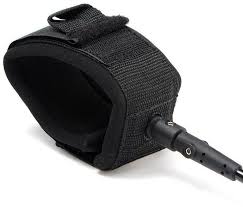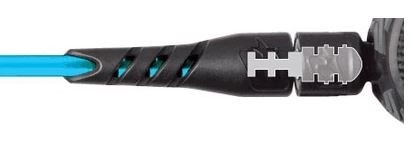In the early 70’s, Pat O’Neill introduced the earliest form of the surfboard leash, setting a course for innovative design that would eventually lead to the urethane and Velcro strap set up today. His leashes have been saving people from long swims back to shore ever since. When it comes to choosing the best surf leash for your board, it can be pretty overwhelming. Especially when you don't know what exactly you need to look for as there are so many different sizes, shapes, lengths and styles to choose from. This guide covers surf leash construction, functionality and how to choose the best surf leash for your riding style.

Cuff
These days it is pretty standard to have a double wrap-around Velcro cuff in order to add extra strength and security to your connection. It is extremely important that the cuff is comfortable and well stitched.
Key Pocket
Some surfboard leashes have a key pocket in the Velcro part that goes around your ankle. Key pockets are a great option for warm water city surfers that need a place to put their car key. It is important to check if the pocket is big enough for your key. Some pockets can be too small for larger car keys. Then again, having a big car key tied around your ankle is not very comfortable and can be the cause for the leash to release from your ankle.
Cord
Most leash cords are made from high quality polyurethane. The thicker the cord, the stronger it will be and the less likely it will break. However, the thicker the cord, the more drag it will create in the water. The thickness of the cord is an important factor when trying to decide the best surf leash for you.
Swivel
Some leashes have a swivel feature at their attachment point to the cuff that allows the leash to spin and twist. A swivel helps prevent the leash from twisting and tangling. A leash that is twisted or tangled is more likely to trip up the rider. It is up to you to decide whether you prefer a one or two bearing swivel, or none at all. Many surfers find the best surf leash contains a two bearing swivel.
Rail Saver
The rail saver is a wide strap section at the end of the leash that attaches to the surfboard. Its job is to provide a secure connection and protect the rail and tail of the surfboard from the cord. The wider and longer the fabric, the more it will protect the rail when you fall off the board and the cord is taut. While longer and wider rail savers may offer more protection, they also create more drag on the water’s surface. It is a matter of personal preference whether you value decreased drag or increased rail protection more.
Length
Length is one of the most important factors when trying to decide on the best surf leash for you. Ranging from 4’ for a kids board to a whopping 12’ for your longest SUP or longboard, there are many different leash lengths to choose from. The length of leash that is right for you will depend on the length of your board and skill level. A leash should be equal in length to or slightly longer than the board it will be used on. This means that you should not be using the same leash on a shortboard as a longboard and vice versa.
If your board is in between sizes, we recommend you round up to the next closest size. Sometimes beginners like to round up as much as 1’ to ensure they will be far away from their board when tumbling through the surf. Then again, one should be aware that this increases the “kill radius” of your board, meaning you are giving your board more reach to potentially hit another surfer. A leash that is too long will add unnecessary drag in the water and slow you down. A leash that is too short is more likely to cause you to fall on your board or for the board to rebound and hit you after the leash is fully stretched.
Thickness
There are two common leash widths, often referred to as competition leashes and regular leashes. Competition leashes are usually around 3/16th of an inch thick while a regular leash will be closer to 5/16th of an inch thick. For all you metric users out there, that’s roughly 4.7mm and 8mm, respectively. When deciding which thickness will constitute the best surf leash, you should consider the length of your board, wave, height, and your surfing experience and ability level.
Regular Leashes
In general, “regular” leashes are more durable due to their thickness. Most beginners and big wave riders should use regular leashes in order to reduce breakage caused by frequent falls or more powerful, bigger waves.
Competition Leashes
These specific leashes are built thinner for a competition setting. It is more important to reduce drag on the water than to have a thicker leash that will last longer and is less likely to break. Competition leashes tangle less than regular leashes due to their thinner profile and are less likely to wrap around legs or fins while waiting for waves in the lineup. Everyone has a different opinion of what wave height warrants a regular leash as opposed to the sleek competition leashes, but in general, a proficient surfer using a board under 7’ should be able to use a competition leash.
Attachment Point: Ankle
Ankle leashes are the most widely used style for several reasons. Most surfers agree that the ankle is the most comfortable spot to attach a leash, especially when paddling. The ankle attachment also allows you to pull back your board with ease when you crash. However, because the attachment is low on the leg, there is a higher chance for entanglement when compared to calf leashes.
Attachment Point: Calf
Calf leashes are almost always used in conjunction with a longboard or SUP. The higher attachment point is ideal for surfers who walk their board a lot. The calf leash also has fewer tangles and less drag in the water. Many say that the calf leash isn’t as comfortable and harder to pull back your board in the water.
Maintenance
Many surfers rinse their surfboard off with fresh water after each session, but tend to overlook their leash. Rinsing the leash off is just as important as it will help increase the lifetime of your leash. It is also important to wash away any sand that comes in contact with the Velcro strap. If too much sand gets into the Velcro, it will not hold during a big wipeout. The last thing is to keep the Velcro strap closed at all times when you are not using. This will keep any other foreign objects from entering the Velcro.
Now that you've chosen the best surf leash for your riding style, you'll need to learn how to attach it to your surfboard. Then, all you need to do is learn how to read a surf report and you'll be set!







